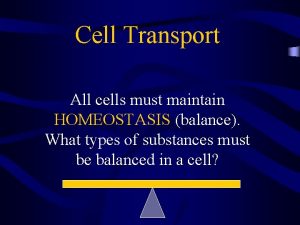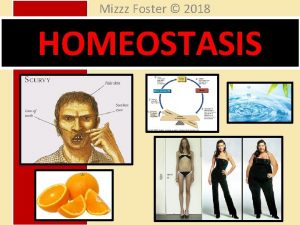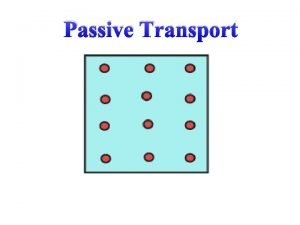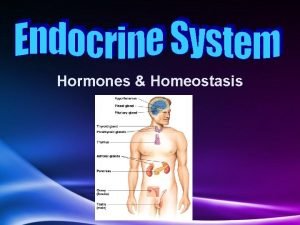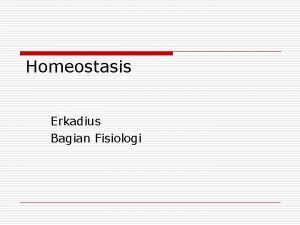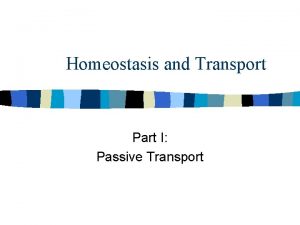Homeostasis Transport Passive Transport Passive Transport v The
























- Slides: 24

Homeostasis & Transport

Passive Transport

Passive Transport v The movement of materials across a cell membrane WITHOUT the use of energy (ATP). v Four Types: n Diffusion n Osmosis n Facilitated Diffusion n Ion Channels

Diffusion n Movement of molecules from an area of high concentration to an area of low concentration.

Diffusion through a Membrane Cell membrane Solute moves DOWN concentration gradient (HIGH to LOW)

Diffusion of Liquids

Diffusion across a membrane n Depends upon size, shape, and chemical makeup n Easy to diffuse: n Small n Nonpolar

Osmosis n WATER diffusion across a membrane n “Down the gradient” n Hypotonic solution to hypertonic solution Osmosis n animation

Osmosis

Hypotonic Solution n The solute concentration is higher inside the cell, the water concentration is higher outside the cell. n Net movement = Water into the cell

Hypertonic Solution n The solute concentration is higher outside the cell, the water concentration is higher inside the cell. n Net movement = Water out of the cell n May cause Plasmolysis

Isotonic Solution n The solute and water concentrations are EQUAL on both sides of the membrane. n Equilibrium


Osmosis in Red Blood Cells Isotonic Hypertonic

hypotonic hypertonic isotonic hypotonic

Facilitated Diffusion n Use of carrier proteins the assist diffusion across a membrane. n Specific carrier proteins for specific molecules (like glucose or amino acids) n “Down the gradient”

Diffusion via ion channels n Use of membrane proteins to assist diffusion of ions across a membrane n Channel is usually specific to 1 type of ion n Common ions: n Sodium n Potassium n Chlorine n Calcium

Active Transport

Active Transport § Uses energy (ATP) to move materials against the gradient § “Up the gradient” § Low to high concentration

1. Sodium Potassium Pump n Transports sodium and potassium ions across the membrane up their gradients n Low to high concentration n Uses ATP

2. Endocytosis n Movement of large amounts of material into the cell n Formation of a vesicle from the cell membrane that will go to the lysosome for digestion n Uses ATP

Moving the “Big Stuff” Large molecules move materials into the cell by one of three forms of endocytosis

3. Exocytosis n The movement of a large amount of materials out of the cell n Vesicle fuses to the cell membrane to release contents out of the cell n Uses ATP

Exocytosis Exocytic vesicle immediately after fusion with plasma membrane.
 Bioflix activity homeostasis low blood glucose
Bioflix activity homeostasis low blood glucose Bioflix activity homeostasis hormones and homeostasis
Bioflix activity homeostasis hormones and homeostasis Homeostasis and cell transport
Homeostasis and cell transport What is homeostasis
What is homeostasis Endocytosis vs exocytosis
Endocytosis vs exocytosis Active transport and passive transport
Active transport and passive transport Passive transport vs active transport venn diagram
Passive transport vs active transport venn diagram Active transport vs passive transport venn diagram
Active transport vs passive transport venn diagram Quá trình desamine hóa có thể tạo ra
Quá trình desamine hóa có thể tạo ra Công của trọng lực
Công của trọng lực Thế nào là mạng điện lắp đặt kiểu nổi
Thế nào là mạng điện lắp đặt kiểu nổi Dạng đột biến một nhiễm là
Dạng đột biến một nhiễm là Bổ thể
Bổ thể Vẽ hình chiếu đứng bằng cạnh của vật thể
Vẽ hình chiếu đứng bằng cạnh của vật thể Biện pháp chống mỏi cơ
Biện pháp chống mỏi cơ độ dài liên kết
độ dài liên kết Môn thể thao bắt đầu bằng chữ f
Môn thể thao bắt đầu bằng chữ f Khi nào hổ mẹ dạy hổ con săn mồi
Khi nào hổ mẹ dạy hổ con săn mồi Thiếu nhi thế giới liên hoan
Thiếu nhi thế giới liên hoan Hát lên người ơi
Hát lên người ơi điện thế nghỉ
điện thế nghỉ Một số thể thơ truyền thống
Một số thể thơ truyền thống Trời xanh đây là của chúng ta thể thơ
Trời xanh đây là của chúng ta thể thơ Số.nguyên tố
Số.nguyên tố Tỉ lệ cơ thể trẻ em
Tỉ lệ cơ thể trẻ em


